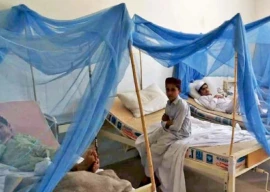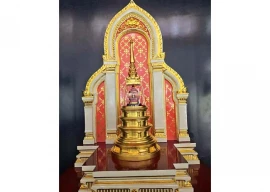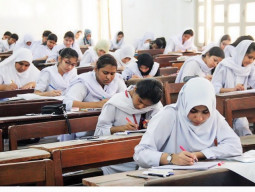
KARACHI:
It is said that art makes life; it creates interest and thus assigns importance. There are few other peaceful substitutes that can compete with the force and beauty of this process. In this respect, the often neglected cartoonist comes to mind, for within him lies the unparalleled ability to simplify and eliminate the unnecessary so that the necessary may speak.
Cartoonists do not merely provide amusement; in fact they address great matters, laying bare the questions which have been hidden by the answers.
For the first time ever, in recognition of the service rendered by the profession, a global level editorial cartoon competition has been announced in Pakistan, where the winning art work can take home a thousand dollars in cash.
The number of entries from Pakistan to date: None.
“I personally approached 27 dailies of Pakistan to inform them of the contest and I am surprised to see absolutely no interest from our country. It’s really sad,” said Hammad Siddiqui, project manager for Centre for International Private Enterprise (Cipe).
Cipe is the organisation which has organised the Global Editorial Cartoon Competition 2011. The contest which is inviting entries till April 17, 2011, has three categories: Democracy, women equality and anti-corruption.
According to the guidelines, there are no restrictions on who can participate in this competition — it is open to both professional and amateur cartoonists of all ages. Participants may submit cartoons in all three categories and a maximum of two cartoons per category.
With such flexible rules, why hasn’t Pakistan shown any interest? The art of editorial cartoons is dying in Pakistan, professional local cartoonists told The Express Tribune.
Feica, a senior cartoonist for Daily Dawn said that editorial cartoons are not respected in Pakistan and people do not understand their power when it comes to disseminating a message. “I get inspirations from burning issues around me,” he said, adding that he thoroughly reads four to five newspapers daily to get ideas for his cartoons.
He said the first barrier they face is within the organisation itself, where editors, more often than not, trash their hard work by terming it non-serious or too controversial. “Moreover, our people are too sensitive; they have not learnt to laugh at themselves. And cartoonists often get into trouble, especially for art work which might exaggerate facial features,” he added. Feica further said that cartoonists also get discouraged when their work is repeatedly rejected or amended, and eventually their work also “loses the cutting edge”.
A graduate of the National College of Arts, Feica said that the new generation is unaware of the power of editorial cartoons and many students prefer the field of graphic design and animations. When asked if he had taken any personal initiatives to promote the art, Feica said that he had approached several colleges and offered to teach students, but his efforts had brought no success.
Indus Valley School of Art and Architecture professor Shehnaz Ismail, endorsed what Feica said. She said that most of her students learnt traditional drawing and sketching at the institution but went on to get jobs in advertising firms and other creative fields, but not into professional cartoon making.
Ismail defended her students by stating that the local print media does not give the graduates any job opportunities in the field of editorial cartoons, otherwise many would be interested in pursuing it as a professional career.
Award winning cartoonist Abdul Karim Rathore whose cartoons appear in the The News, held another opinion altogether on the matter of the future of cartoons. He said, “Cartoonists cannot be made, they are born with God-gifted talent. In Pakistan, no one has that talent any more. What we see today are works of senior cartoonists, the youth just adds colour to meaningless designs with no impact and calls it art work.”
Referring to political cartoons, Rathore said that their power can be estimated from the uproar some blasphemous cartoons had created in the entire world. “Caricatures, which are not taken seriously in Pakistan, brought people out on the streets and shook the economy of some countries — that is the strength editorial cartoons have,” he expressed.
Social media expert Ashraf Chaudhry agreed that political cartoons can have massive impact, but to reach to the masses to create that level of impact, “They need to be unique, funny and controversial”.
“I have never seen any reference to cartoons on any of the popular social networking websites from Pakistan, and neither do our local popular websites give them due coverage,” he said, further adding that the lack of awareness of social media was the likely reason that Pakistan failed to participate in the contest as yet.
Published in The Express Tribune, April 01st, 2011.















































COMMENTS (2)
Comments are moderated and generally will be posted if they are on-topic and not abusive.
For more information, please see our Comments FAQ